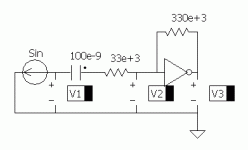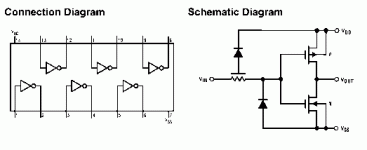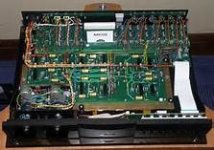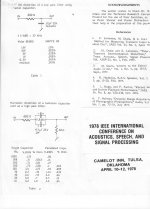Sy must use balanced connections on the critical stuff or otherwise is isolating his signal ground from power ground.
Yes to both.
The Bateman articles look at voltage distortion (really harmonic generation) across caps. Possibly looking at current distortion would be more relevant in a power supply. In a supply you have a low Z DC voltage and you are superimposing a varying current. The question would be the magnitude of the harmonically related currents. When the cap impedance is in the milliOhms at the frequency of interest the voltage is guaranteed to be very small. Tantalums have very low leakage and low esr up to pretty high frequencies. If you were using them in a crossover it could be a real problem because you are operating where they have significant reactance. In a power supply the reactance is much lower. But you could have high q resonant tanks with the multiple caps and power distribution connections. No easy answers.
That's a pretty good answer though.
On tantalum.
I have yet to see a better cap for low current level filtering. Years ago, I opened up a Beckman blood analyzer device - it was chock full of tantalums on each leg od each IC inside, and there are a LOT of ICs inside. Just one tantalum, 10 uF/25V, no usual 100 nF bypasses, nothing. Ditto for an HP oscilloscope I also saw opened up at about the same time.
But I would never use then inside an audio circuit. The few tests I did on them years ago clearly showed they tend to darken the sound and kill off a lot of detail.
I wonder if that is the Voltage distortion or if it's electro-mechanical resonance.
I've seen quite a few high-end products online which use them, it's possible some people think that "detail killing" so to speak, if real, sounds more analog or pretty somehow.
Haha.
You appear to be proposing that some distortion mechanism in capacitors does not generate a distorted voltage but a distorted current. Let us postulate such a mechanism. If it produces a current then this current must be in parallel with the capacitor (just as any voltage distortion is effectively in series with it). By design, the capacitor has a low impedance at freqencies of interest. Therefore the current is largely shorted out. The resultant small voltage is what Bateman has already seen.1audio said:The Bateman articles look at voltage distortion (really harmonic generation) across caps. Possibly looking at current distortion would be more relevant in a power supply. In a supply you have a low Z DC voltage and you are superimposing a varying current. The question would be the magnitude of the harmonically related currents. When the cap impedance is in the milliOhms at the frequency of interest the voltage is guaranteed to be very small.
Nothing new to see.
A question for the Gurus :
With the circuit shown below I obtained
the following readings while comparing operation
@ 3.3V, 5.0V, and 12V .....
..........3.30V..........5.00V.........12.0V
V1.......0.13V..........0.14V.........0.18V
V2.......0.02V..........0.04V.........0.06V
V3.......1.00V..........1.00V.........1.00V
Obviously the open loop gain goes down as the voltage increases.
Why ? For some reason I would expect the opposent .....
With the circuit shown below I obtained
the following readings while comparing operation
@ 3.3V, 5.0V, and 12V .....
..........3.30V..........5.00V.........12.0V
V1.......0.13V..........0.14V.........0.18V
V2.......0.02V..........0.04V.........0.06V
V3.......1.00V..........1.00V.........1.00V
Obviously the open loop gain goes down as the voltage increases.
Why ? For some reason I would expect the opposent .....
Attachments
I recently heard the $250,000 Naim Statement amplifiers on large Focal speakers. It had dozens of tantalum capacitors on the various boards, most likely are in local regulators and housekeeping functions, but Naim have steadfastly stuck with them for signal coupling for decades beyond when most designers have gone to direct coupling, servos , film , caps, or bipolar electrolytics. Lots of power and dynamics, but not very resolving or worth the asking price..
Naim's recent product upgrade of Discrete Regulators in most of their top of the line range after 20 years of after market moders doing so. The basic topology of the DR regulators is that of the updated Jung super regulator (2000 version) with a few refinements and housekeeping functions - also with a sprinkling of tantalum capacitors.
The 552 $30,000. Preamp View attachment 83
Naim's recent product upgrade of Discrete Regulators in most of their top of the line range after 20 years of after market moders doing so. The basic topology of the DR regulators is that of the updated Jung super regulator (2000 version) with a few refinements and housekeeping functions - also with a sprinkling of tantalum capacitors.
The 552 $30,000. Preamp View attachment 83
Attachments
Last edited:
That's one way to do it. The other is to own, or have access to, a Russian military grade 'scope from 1990 or later, which has some very nice add-ons supplied as standard.
Its only problem is that you shouldn't try to lift it, or you might get lumbago. And don't kick it, you'll break your foot.
Tell me about it. I used to have a Tek 570 tube curve tracer.
This is what happens when a company only looks to itself as the only source of knowledge. I knew Julian Vereker, the originator of Naim, very well in the 70's and 80's. I learned a bit from Julian, but both he and Ivor T. never listened up when I showed them the problems with Tantalum caps. Rather sad really. Now, they go on with whatever they are left with.
The tests by Bateman and Self etal are for a condition of minimum ac voltage drop across the capacitor. That is a normal condition for coupling caps.
In applications, such as, EQ, RIAA, Filtering, there is a voltage drop across the capacitor and that is another normal condition. When there is a voltage drop across the cap, there will be distortion produced.
The only source of this distortion is from the dielectric material (neglecting construction defects). The material with the lowest distortion has the lowest DA (dielectric absorption).
With polar dielectrics, such as electrolytic and Tantalum, even in coupling applications, they can be heard in some mfr'ed gear. So, I suggested the now popular "DC Servo" circuit. But in other applications where the cap is an important part of the filter/EQ circuit, only better quality dielectrics can be used..... those with lowest DA. This is the basic culmination of knowledge for audio applications I wrote with W.Jung in Audio magazine many decades ago.
THx-RNMarsh
In applications, such as, EQ, RIAA, Filtering, there is a voltage drop across the capacitor and that is another normal condition. When there is a voltage drop across the cap, there will be distortion produced.
The only source of this distortion is from the dielectric material (neglecting construction defects). The material with the lowest distortion has the lowest DA (dielectric absorption).
With polar dielectrics, such as electrolytic and Tantalum, even in coupling applications, they can be heard in some mfr'ed gear. So, I suggested the now popular "DC Servo" circuit. But in other applications where the cap is an important part of the filter/EQ circuit, only better quality dielectrics can be used..... those with lowest DA. This is the basic culmination of knowledge for audio applications I wrote with W.Jung in Audio magazine many decades ago.
THx-RNMarsh
Last edited:
In view of John's and Richard's posts above, I feel justified for refusing to use tantalum in an active circuit as a decoupling element.
To be sure, I never went as far as measuring the distorion aided and abetted by tantalum caps, but they simply sounded more oblique to me, with a notable loss of ambient detail. Didn't have the gear I have today, anyway.
Linn amps I have not heard, but Naim amps I have heard and I must say that they have a very specific character, which, while seductive on first go, starts to irritate me over protracted listening times. Obviously a very personal view, as Naim fans swear by it.
To be sure, I never went as far as measuring the distorion aided and abetted by tantalum caps, but they simply sounded more oblique to me, with a notable loss of ambient detail. Didn't have the gear I have today, anyway.
Linn amps I have not heard, but Naim amps I have heard and I must say that they have a very specific character, which, while seductive on first go, starts to irritate me over protracted listening times. Obviously a very personal view, as Naim fans swear by it.
Here is what I showed Julian and Ivor back before 1980. They sadly ignored it.
Why sadly? Their products seem do do quite well.
Well Jan, they do have a faithful following, but then, after all the media support they got from the British press, that's hardly surprising.
If they were doing so well, how come they are now owned by Focal of France?
Had they taken a different approach, who's to say how much better they might have fared?
I think John's note regarding them being stuck with what they had says a lot. That was, in my view, the key reason why so many otherwise excellent manufacturers from Britain are no more - Armstrong jumps to mind. They did try to keep up, but it came way too late and was way too small. Ditto for most of the German companies now long gone - they wasted 10 years promoting quadro when everybody else had dropped it long ago, and they never realized that the market demanded more power. By the time they caught on, it was too late.
If they were doing so well, how come they are now owned by Focal of France?
Had they taken a different approach, who's to say how much better they might have fared?
I think John's note regarding them being stuck with what they had says a lot. That was, in my view, the key reason why so many otherwise excellent manufacturers from Britain are no more - Armstrong jumps to mind. They did try to keep up, but it came way too late and was way too small. Ditto for most of the German companies now long gone - they wasted 10 years promoting quadro when everybody else had dropped it long ago, and they never realized that the market demanded more power. By the time they caught on, it was too late.
I recently heard the $250,000 Naim Statement amplifiers on large Focal speakers. It had dozens of tantalum capacitors on the various boards, most likely are in local regulators and housekeeping functions, but Naim have steadfastly stuck with them for signal coupling for decades beyond when most designers have gone to direct coupling, servos , film , caps, or bipolar electrolytics. Lots of power and dynamics, but not very resolving or worth the asking price..
Naim's recent product upgrade of Discrete Regulators in most of their top of the line range after 20 years of after market moders doing so. The basic topology of the DR regulators is that of the updated Jung super regulator (2000 version) with a few refinements and housekeeping functions - also with a sprinkling of tantalum capacitors.
The 552 $30,000. Preamp View attachment 83
I think John's note regarding them being stuck with what they had says a lot. That was, in my view, the key reason why so many otherwise excellent manufacturers from Britain are no more - Armstrong jumps to mind. They did try to keep up, but it came way too late and was way too small. Ditto for most of the German companies now long gone - they wasted 10 years promoting quadro when everybody else had dropped it long ago, and they never realized that the market demanded more power. By the time they caught on, it was too late.
You are not suggesting that all these companies would still be here had they only replaced their tantalums?
Jan
I haven’t seen German products using tantalums as coupling caps. In the early 60ies (tubes) mostly paper caps, later polysomething (tubes) and alum electrolytics (SS)
It seems that Naim survived and does better than most British Hi-Fi brand names of the 70ies (who all got a strong media support from the British press), as well as better than the German brand names
If the Naim’s recipe for success is based on taltalum caps, that would be a wonder recipe and tantalum would be a wonder cap.
If on the other hand tantalum caps are really distorting, Naim would have one more reason to disappear from the market before the other firms did.
George
It seems that Naim survived and does better than most British Hi-Fi brand names of the 70ies (who all got a strong media support from the British press), as well as better than the German brand names
If the Naim’s recipe for success is based on taltalum caps, that would be a wonder recipe and tantalum would be a wonder cap.
If on the other hand tantalum caps are really distorting, Naim would have one more reason to disappear from the market before the other firms did.
George
Last edited:
If on the other hand tantalum caps are really distorting, Naim would have one more reason to disappear from the market before the other firms did.
George
The fallacy in this reasoning is that it assumes that success of a company depends on objective sound quality.
Jan
how come they are now owned by Focal of France?
They're not.
A couple of years ago, both companies merged simply by swapping out some stock.
Earlier this year, 2 French private equity companies took over a majority share number of both firms. (the common story, when the founder of a company comes at age and wishes to slow down)
- Status
- Not open for further replies.
- Home
- Member Areas
- The Lounge
- John Curl's Blowtorch preamplifier part II



